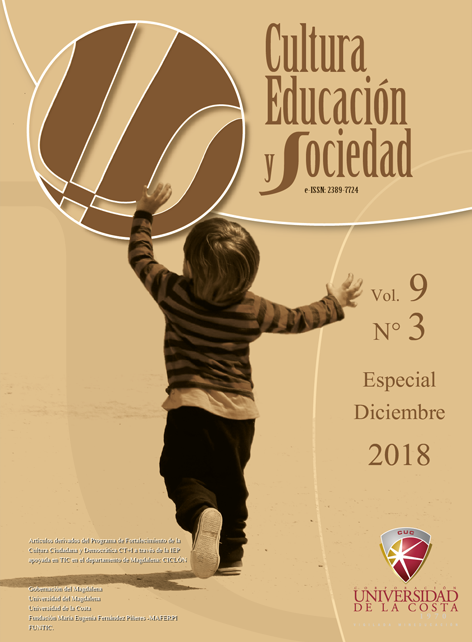Ludo-Mathematical Laboratory, Geometric-Metric Thinking Potentiator in Preschool
DOI:
https://doi.org/10.17981/cultedusoc.9.3.2018.62Keywords:
Mathematics Laboratory; Metric Geometric Thought; Playful to know; school.Abstract
The learning of mathematics at the beginning of school life, is a challenge for the educator, because of the complexity that the contents have, reason. The objective of the present study was to identify the knowledge that students have about mathematics to create a ludo-mathematical laboratory based on the use of tics as an enhancing tool of geometrical-metric thinking in preschool. The research is based on a quantitative view, and the teachers of the Camilo Torres de Algarrobal headquarters in the Municipality of Banco Magdalena were worked on. As an instrument for gathering information, a structured interview was conducted. The results allow to show that the students in their first school years are difficult to learn mathematics, however they have basic knowledge. Regarding motivation and participation, we find that it is more motivating to learn if the spaces are interactive and recreational.
Downloads
References
Camargo, L (2011). El legado de Piaget a la didáctica de la Geometría. Revista Colombiana de Educación, N.º 60. Bogotá, Colombia.
Colorear, F. (2016). Figuras Geométricas -Dibujos para colorear. [online] Cicloescolar.com. Available at: http://www.cicloescolar.com/2012/11/figuras-geometricas-dibujos-para.html [Accessed 16 Dec. 2016].
Dou, A. (s.f). Orígenes de la geometría no euclidiana saccheri, lambert y taurinus(eds.), pp. 21
G.M. Bruño. Elementos De Geometría. Editorial librería del a Vda. de C bouret. Pp.96-97. 105.
Godino, J (2012). “Medida de magnitudes y su didáctica para maestros” http://www.ugr.es/local/jgodino/edumat-maestros/.
Guerrero, A. (2006). Desarrollo axiomático. Editorial Ecoe Ediciones. Bogotá .
ICFES (2011). “Orientaciones para el examen de estado de la educación media. Icfes saber 11” http://www.slideshare.net/cikey/guia-saber-Ludica.org. (2017). La Lúdica, el Constructivismo y el Aprendizaje Experiencial | Ernesto Yturralde Worldwide Inc.. [online] Available at: http://www.ludica.org/ Manual de convivencia, Institución Educativa La Rivera.
Herrera, B., Certain, R., & Calderón, M (2014).La norma hipotética fundamental desde el Paradigma Interpretativo. Justicia Juris, 10(2), 17-27.
Landinez-Lamadrid, D. C., Ramirez-Ríos, D. G., Neira Rodado, D., Parra Negrete, K., & Combita Niño, J. P. (2017). Shapley Value: its algorithms and application to supply chains. INGE CUC, 13(1), 61-69. https://doi.org/10.17981/ingecuc.13.1.2017.06
Luengo R. (s.f). Colección cultura y aprendizaje. “Proporcionalidad Geométrica y Semejanza.” No.14. editorial Síntesis. Pp.47-71, 80-86.
Marcos, G (2013). Un modelo de competencias matemáticas en un entorno interactivo. pdf, Universidad de la Rioja, http:dialnet.unirioja.es/servlet/fichero_tesis?.
Marín Grajales, D. F. (2014). Estrategias didácticas para fortalecer el pensamiento geométrico en estudiantes de grado sexto.
Ministerio de Educación Nacional. (2011). Lineamientos curriculares documento recuperado de:http://www.mineducacion.gov.co/lineamientos/matematicas/matematicas.pdf
OCDE. (2014). Marco de la evaluación. Conocimientos y habilidades en ciencias, matemáticas y lectura. PISA, Perfil, V. (2016). Cuerpos geométricos. Actividades. [online] Aulasory.blogspot.com.co. Available at: http://aulasory.blogspot.com.co/2011/09/cuerpos-geometricos-actividades.html.
Pérez-Acosta, & Urrá, M. (2015). El Premio Rubén Ardila a la investigación científica en psicología (2005-2015): De la psicología organizada a la historia de las ciencias del comportamiento. Cultura Educación y Sociedad, 6(2), 77-89. Recuperado de: https://revistascientificas.cuc.edu.co/index.php/culturaeducacionysociedad/article/view/1042
Salamanca, M. L. P., Lombana, N. B., & Holguín, W. J. P. (2010). Uso de la robótica educativa como herramienta en los procesos de enseñanza. Ingeniería Investigación y Desarrollo, 10(1).
Downloads
Published
How to Cite
Issue
Section
License
Copyright (c) 2018 CULTURA EDUCACIÓN Y SOCIEDAD

This work is licensed under a Creative Commons Attribution-NonCommercial-NoDerivatives 4.0 International License.
![]()
Creative Commons 2020 CULTURA EDUCACIÓN Y SOCIEDAD
This article is under international license Creative Commons Reconocimiento-NoComercial-SinObrasDerivadas 4.0.
The published articles are the sole responsibility of their authors and do not necessarily reflect the opinions of the editorial committee.
CULTURA EDUCACIÓN Y SOCIEDAD respects the moral rights of its authors, who assign to the editorial committee the patrimonial rights of the published material. In turn, the authors inform that this work is unpublished and has not been previously published.
All articles are under a:
Licencia Creative Commons Atribución-NoComercial-SinDerivadas 4.0 Internacional.
![]()


 English
English
 Español (España)
Español (España)




_12.53_.27_p_. m_._3.png)





_12.57_.35_p_. m_._3.png)
_12.50_.37_p_. m_._3.png)



